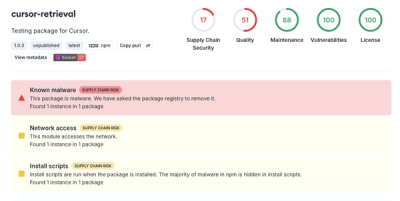
Security News
The Risks of Misguided Research in Supply Chain Security
Snyk's use of malicious npm packages for research raises ethical concerns, highlighting risks in public deployment, data exfiltration, and unauthorized testing.
btakita-jsdom
Advanced tools
A JavaScript implementation of the WHATWG DOM and HTML standards.
$ npm install jsdom
If this gives you trouble with errors about installing Contextify, especially on Windows, see below.
see: mailing list
Bootstrapping a DOM is generally a difficult process involving many error prone steps. We didn't want jsdom to fall into the same trap and that is why a new method, jsdom.env(), has been added in jsdom 0.2.0 which should make everyone's lives easier.
You can use it with a URL
// Count all of the links from the Node.js build page
var jsdom = require("jsdom");
jsdom.env(
"http://nodejs.org/dist/",
["http://code.jquery.com/jquery.js"],
function (errors, window) {
console.log("there have been", window.$("a").length, "nodejs releases!");
}
);
or with raw HTML
// Run some jQuery on a html fragment
var jsdom = require("jsdom");
jsdom.env(
'<p><a class="the-link" href="https://github.com/tmpvar/jsdom">jsdom\'s Homepage</a></p>',
["http://code.jquery.com/jquery.js"],
function (errors, window) {
console.log("contents of a.the-link:", window.$("a.the-link").text());
}
);
or with a configuration object
// Print all of the news items on hackernews
var jsdom = require("jsdom");
jsdom.env({
url: "http://news.ycombinator.com/",
scripts: ["http://code.jquery.com/jquery.js"],
done: function (errors, window) {
var $ = window.$;
console.log("HN Links");
$("td.title:not(:last) a").each(function() {
console.log(" -", $(this).text());
});
}
});
or with raw JavaScript source
// Print all of the news items on hackernews
var jsdom = require("jsdom");
var fs = require("fs");
var jquery = fs.readFileSync("./jquery.js", "utf-8");
jsdom.env({
url: "http://news.ycombinator.com/",
src: [jquery],
done: function (errors, window) {
var $ = window.$;
console.log("HN Links");
$("td.title:not(:last) a").each(function () {
console.log(" -", $(this).text());
});
}
});
jsdom.env is built for ease of use, which is rare in the world of the DOM! Since the web has some absolutely horrible JavaScript on it, as of jsdom 0.2.0 jsdom.env will not process external resources (scripts, images, etc). If you want to process the JavaScript use one of the methods below (jsdom.jsdom or jsdom.jQueryify)
jsdom.env(string, [scripts], [config], callback);
The arguments are:
string: may be a URL, file name, or HTML fragmentscripts: a string or array of strings, containing file names or URLs that will be inserted as <script> tagsconfig: see belowcallback: takes two arguments
error: either an Error object if something failed initializing the window, or an array of error messages from the DOM if there were script errorswindow: a brand new windowExample:
jsdom.env(html, function (errors, window) {
// free memory associated with the window
window.close();
});
If you would like to specify a configuration object only:
jsdom.env(config);
config.html: a HTML fragmentconfig.file: a file which jsdom will load HTML from; the resulting window's location.href will be a file:// URL.config.url: sets the resulting window's location.href; if config.html and config.file are not provided, jsdom will load HTML from this URL.config.scripts: see scripts above.config.src: an array of JavaScript strings that will be evaluated against the resulting document. Similar to scripts, but it accepts JavaScript instead of paths/URLs.config.jar: a custom cookie jar, if desired; see mikeal/request documentation.config.done: see callback above.config.document:
referrer: the new document will have this referrer.cookie: manually set a cookie value, e.g. 'key=value; expires=Wed, Sep 21 2011 12:00:00 GMT; path=/'.cookieDomain: a cookie domain for the manually set cookie; defaults to 127.0.0.1.config.features : see Flexibility section below. Note: the default feature set for jsdom.env does not include fetching remote JavaScript and executing it. This is something that you will need to carefully enable yourself.Note that config.done is required, as is one of config.html, config.file, or config.url.
If you want to spawn a document/window and specify all sorts of options this is the section for you. This section covers the jsdom.jsdom method:
var jsdom = require("jsdom").jsdom;
var doc = jsdom(markup, level, options);
var window = doc.parentWindow;
markup is an HTML/XML document to be parsed. You can also pass null or an undefined value to get a basic document with empty <head> and <body> tags. Document fragments are also supported (including ""), and will behave as sanely as possible (e.g. the resulting document will lack the head, body and documentElement properties if the corresponding elements aren't included).
level is null (which means level3) by default, but you can pass another level if you'd like.
var jsdom = require("jsdom");
var doc = jsdom.jsdom("<html><body></body></html>", jsdom.level(1, "core"));
options See the explanation of the config object above.
One of the goals of jsdom is to be as minimal and light as possible. This section details how someone can change the behavior of Documents on the fly. These features are baked into the DOMImplementation that every Document has, and may be tweaked in two ways:
Document using the jsdom builder (require("jsdom").jsdom())var jsdom = require("jsdom").jsdom;
var doc = jsdom("<html><body></body></html>", null, {
features: {
FetchExternalResources : ["img"]
}
});
Do note, that this will only affect the document that is currently being created. All other documents will use the defaults specified below (see: Default Features).
require("jsdom").defaultDocumentFeatures = {
FetchExternalResources: ["script"],
ProcessExternalResources: false
};
Default features are extremely important for jsdom as they lower the configuration requirement and present developers a set of consistent default behaviors. The following sections detail the available features, their defaults, and the values that jsdom uses.
FetchExternalResources
["script"]["script", "img", "css", "frame", "iframe", "link"] or falseEnables/disables fetching files over the file system/HTTP.
ProcessExternalResources
["script"]["script"] or falseDisabling this will disable script execution (currently only JavaScript).
SkipExternalResources
false/url to be skipped/ or false/http:\/\/example.org/js/bad\.js/Do not download and process resources with url matching a regular expression.
jsdom includes support for using the canvas package to extend any <canvas> elements with the canvas API. To make this work, you need to include canvas as a dependency in your project, as a peer of jsdom. If jsdom can find the canvas package, it will use it, but if it's not present, then <canvas> elements will behave like <div>s.
var jsdom = require("jsdom");
var doc = new (jsdom.level(1, "core").Document)();
console.log(doc.nodeName); // outputs: #document
var jsdom = require("jsdom").jsdom;
var document = jsdom("<html><head></head><body>hello world</body></html>");
var window = document.parentWindow;
console.log(window.document.innerHTML);
// output: "<html><head></head><body>hello world</body></html>"
console.log(window.innerWidth);
// output: 1024
console.log(typeof window.document.getElementsByClassName);
// outputs: function
var jsdom = require("jsdom");
var window = jsdom.jsdom().parentWindow;
jsdom.jQueryify(window, "http://code.jquery.com/jquery.js", function () {
window.$("body").append('<div class="testing">Hello World, It works</div>');
console.log(window.$(".testing").text());
});
var jsdom = require("jsdom").jsdom;
var window = jsdom().parentWindow;
window.__myObject = { foo: "bar" };
var scriptEl = window.document.createElement("script");
scriptEl.src = "anotherScript.js";
window.document.body.appendChild(scriptEl);
// anotherScript.js will have the ability to read `window.__myObject`, even
// though it originated in Node!
First you'll want to npm install. To run all the tests, use npm test, which just calls node test/runner.
Using test/runner directly, you can slice and dice which tests your want to run from different levels. Usage is as follows:
test/runner --help
Run the jsdom test suite
Options:
-s, --suites suites that you want to run. ie: -s level1/core,1/html,html [string]
-f, --fail-fast stop on the first failed test
-h, --help show the help
-t, --tests choose the test cases to run. ie: -t jquery
Contextify is a dependency of jsdom, used for running <script> tags within the
page. In other words, it allows jsdom, which is run in Node.js, to run strings of JavaScript in an isolated environment
that pretends to be a browser environment instead of a server. You can see how this is an important feature.
Unfortunately, doing this kind of magic requires C++. And in Node.js, using C++ from JavaScript means using "native modules." Native modules are compiled at installation time so that they work precisely for your machine; that is, you don't download a contextify binary from npm, but instead build one locally after downloading the source from npm.
Unfortunately, getting C++ compiled within npm's installation system can be tricky, especially for Windows users. Thus, one of the most common problems with jsdom is trying to use it without the proper compilation tools installed. Here's what you need to compile Contextify, and thus to install jsdom:
C:\Python27.There are some slight modifications to this that can work; for example full versions of Visual Studio usually work, and sometimes you can even get an x64 version of Node.js working too. But it's tricky, so start with the basics!
You'll need various build tools installed, like make, Python 2.7, and a compiler toolchain. How to install these will
be specific to your distro, if you don't already have them.
FAQs
A JavaScript implementation of the DOM and HTML standards
We found that btakita-jsdom demonstrated a not healthy version release cadence and project activity because the last version was released a year ago. It has 1 open source maintainer collaborating on the project.
Did you know?

Socket for GitHub automatically highlights issues in each pull request and monitors the health of all your open source dependencies. Discover the contents of your packages and block harmful activity before you install or update your dependencies.

Security News
Snyk's use of malicious npm packages for research raises ethical concerns, highlighting risks in public deployment, data exfiltration, and unauthorized testing.

Research
Security News
Socket researchers found several malicious npm packages typosquatting Chalk and Chokidar, targeting Node.js developers with kill switches and data theft.

Security News
pnpm 10 blocks lifecycle scripts by default to improve security, addressing supply chain attack risks but sparking debate over compatibility and workflow changes.